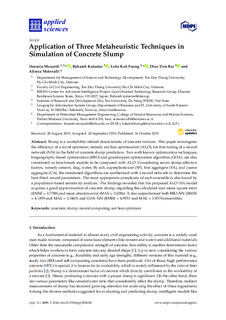Application of Three Metaheuristic Techniques in Simulation of Concrete Slump
Journal article, Peer reviewed
Published version
Permanent lenke
http://hdl.handle.net/11250/2632894Utgivelsesdato
2019Metadata
Vis full innførselSamlinger
- Institutt for økonomi og it [152]
- Publikasjoner fra CRIStin [3401]
Sammendrag
Slump is a workability-related characteristic of concrete mixture. This paper investigates the efficiency of a novel optimizer, namely ant lion optimization (ALO), for fine-tuning of a neural network (NN) in the field of concrete slump prediction. Two well-known optimization techniques, biogeography-based optimization (BBO) and grasshopper optimization algorithm (GOA), are also considered as benchmark models to be compared with ALO. Considering seven slump effective factors, namely cement, slag, water, fly ash, superplasticizer (SP), fine aggregate (FA), and coarse aggregate (CA), the mentioned algorithms are synthesized with a neural network to determine the best-fitted neural parameters. The most appropriate complexity of each ensemble is also found by a population-based sensitivity analysis. The findings revealed that the proposed ALO-NN model acquires a good approximation of concrete slump, regarding the calculated root mean square error (RMSE = 3.7788) and mean absolute error (MAE = 3.0286). It also outperformed both BBO-NN (RMSE = 4.1859 and MAE = 3.3465) and GOA-NN (RMSE = 4.9553 and MAE = 3.8576) ensembles
Beskrivelse
This article is an open access article distributed under the terms and conditions of the Creative Commons Attribution (CC BY) license.

